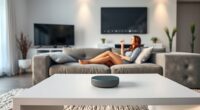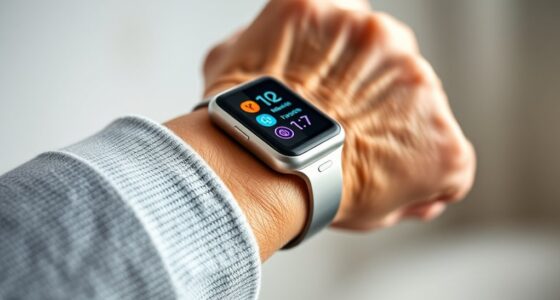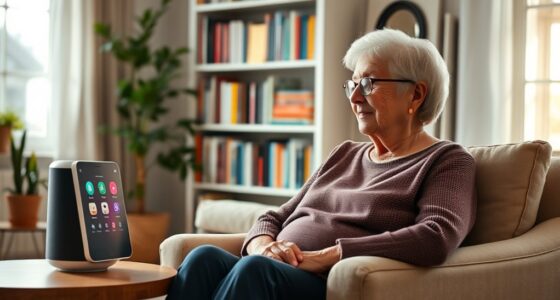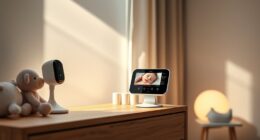Smart home devices help you monitor safety, health, and daily routines remotely, giving you peace of mind. Sensors and cameras detect falls, hazards, or suspicious activity, while wearable monitors track crucial signs and alert you immediately if issues arise. Voice assistants and automation make communication easier and keep daily tasks on schedule. Smart security and emergency systems ensure quick responses during crises. Keep exploring to discover how these tools can transform caregiving and support independence even more.
Key Takeaways
- Enable remote monitoring of seniors’ safety, health status, and daily activities for timely caregiver intervention.
- Automate routine tasks like lighting, medication reminders, and environmental controls to reduce caregiver workload.
- Provide real-time alerts for falls, emergencies, or hazards, ensuring swift response and enhanced safety.
- Support social connection through voice assistants and communication tools, reducing feelings of isolation.
- Enhance security and emergency preparedness with sensors, cameras, and automated alerts for quick assistance.
Enhancing Safety With Smart Security Solutions
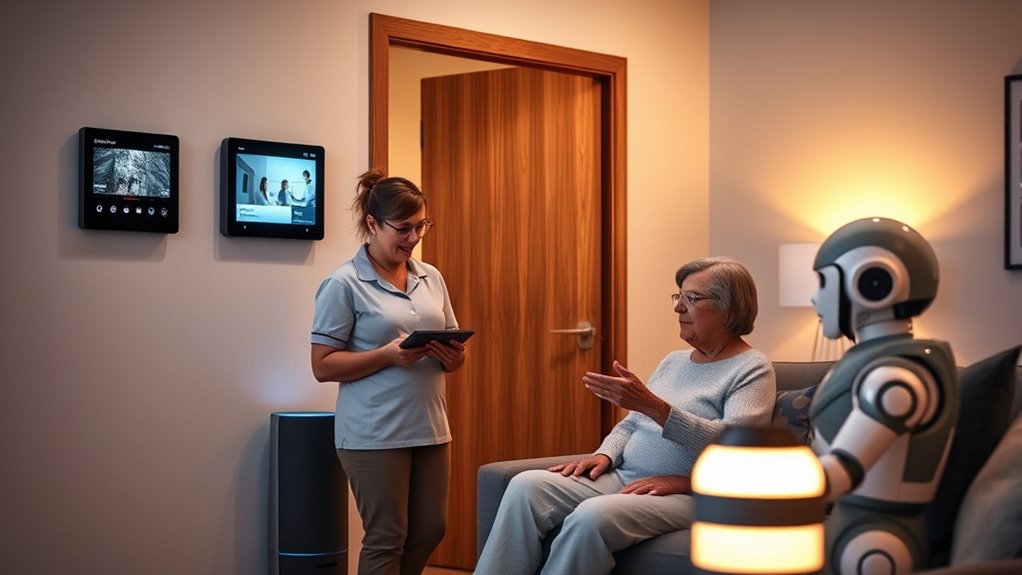
Smart security solutions play a vital role in enhancing safety for older adults living alone. With smart security, you can monitor your loved one’s home through sensors and cameras that detect falls, suspicious activity, or security breaches. Studies show that integrating these devices can significantly reduce the risk of burglaries and improve response times during emergencies. Devices like door/window sensors and water leak detectors offer extensive safety coverage, alerting you instantly to potential hazards. Indoor and outdoor cameras enable remote, real-time surveillance, so you can quickly identify emergencies or falls. Automated alerts notify caregivers or emergency services right away, reducing response times and increasing safety. Additionally, the use of high contrast projectors can improve visibility of security footage and alerts in various lighting conditions, further supporting safety efforts. Implementing AI security technologies can enhance threat detection and provide smarter alerts tailored to your loved one’s specific needs. DIY security setups are affordable and easy to manage, supporting independence while ensuring safety. According to security system evaluations, user-friendly interfaces and reliable performance are crucial for effective emergency management. When combined with professional monitoring plans, these systems provide peace of mind, knowing help is just a notification away whenever safety concerns arise.
Monitoring Health and Well-Being Remotely
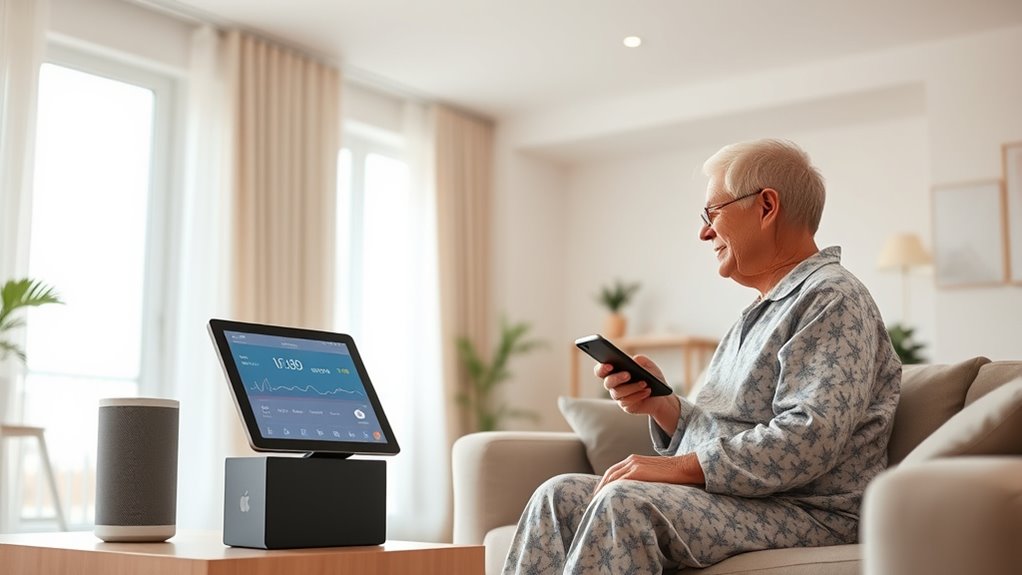
Smart home devices let you monitor an older adult’s health and daily activities from afar, giving you real-time updates on their well-being. With alerts for falls or unusual activity, you can respond quickly and confidently. Additionally, tools like smart pill dispensers and reminders help guarantee medication adherence without constant oversight. Incorporating remote work principles can also improve the efficiency of caregiving routines by allowing flexible check-ins and support. Moreover, understanding AI-driven solutions can assist caregivers in leveraging innovative technologies for better care management. Additionally, understanding Louisiana alimony laws can assist caregivers in planning for financial stability during and after caregiving responsibilities. Using portable medical devices such as portable blood pressure monitors or glucose meters can further enhance remote health monitoring, providing more comprehensive data for caregivers.
Real-Time Health Alerts
Real-time health alerts enable caregivers to monitor the well-being of loved ones remotely with immediate notifications of emergencies or abnormal essential signs. Smart home devices, such as wearable monitors and sensors, detect issues like falls or irregular heartbeats instantly, alerting you right away. Glycolic acid benefits can also enhance skin health for users interested in skin care alongside health monitoring. These alerts keep you informed about critical signs such as blood pressure, oxygen levels, and ECG data, providing continuous oversight without the need for physical visits. Incorporating home automation allows for seamless integration of multiple health monitoring devices, streamlining the process and enhancing overall safety. Automated notifications from smart devices ensure you can respond swiftly to health changes, reducing response times and potentially preventing serious incidents. Integrating these sensors with smart platforms offers instant alerts via smartphones or voice assistants, enhancing safety and peace of mind. Additionally, remote monitoring capabilities enable healthcare professionals to assist caregivers by providing expert guidance and support from afar. The development of AI security measures ensures that sensitive health data remains protected against breaches and unauthorized access. Utilizing health data integration can further improve the accuracy and comprehensiveness of monitoring, leading to better health outcomes. With real-time health alerts, you can support aging in place and ensure your loved ones stay safe.
Activity and Movement Tracking
Activity and movement tracking devices, such as motion sensors and wearable monitors, allow you to observe an older adult’s daily routines and mobility remotely. These tools provide real-time monitoring of movement and activity levels, helping you identify any unusual patterns or inactivity that could signal health concerns. Utilizing filtration systems, such as sensors that detect air quality, can further enhance the overall safety and comfort of your care environment. Smart cameras with motion detection enable you to oversee safety incidents without being physically present, enhancing safety and peace of mind. Movement data collected over time helps you spot trends in mobility, allowing you to adjust care plans proactively. Immediate alerts for falls, extended inactivity, or emergencies ensure you can respond swiftly, reducing risks and supporting overall well-being. These devices make monitoring safer, more efficient, and less intrusive, giving you confidence in caring from afar. Incorporating local resources can also connect you with additional support and guidance tailored to your specific caregiving situation. Additionally, understanding Kia Tuning options can inspire modifications that improve vehicle handling and safety, ensuring reliable transportation for caregivers and loved ones. Moreover, integrating air quality sensors can help maintain a healthier environment, which is crucial for individuals with respiratory issues or sensitivities.
Medication and Reminder Management
Ever worry about whether your loved one is taking their medications as prescribed? Smart home devices like smart pill dispensers make medication management easier and safer. These devices automate doses, reducing errors, and send reminders when it’s time to take medications. They also often include personalized scheduling features that can be tailored to individual needs, enhancing treatment adherence.
With programmed schedules and alarms, they support seniors’ independence while guaranteeing they don’t miss doses. Remote monitoring features allow you to verify medication compliance and receive alerts if doses are missed, giving you peace of mind. Additionally, integrating medication adherence technologies can further enhance the safety and effectiveness of medication routines. Many of these devices are compatible with retail services, allowing easy replenishment of supplies and medications. Incorporating digital health monitoring can provide comprehensive insights into your loved one’s overall health status.
Smart pill dispensers also help prevent dangerous drug interactions and accidental overdoses, especially for those with complex regimens or cognitive decline. Incorporating these tools into your loved one’s home ensures safer, more autonomous living and keeps you informed about their health from afar. Floating on water can also be incorporated into therapeutic routines to promote relaxation and overall well-being.
Simplifying Communication and Social Connection

How can smart home devices make communication easier for caregivers and seniors? Voice assistants like Amazon Echo Show 8 simplify caregiver communication by enabling easy voice commands for calls and messages. Efficient payment processing solutions ensure secure and seamless interactions, fostering trust and convenience for users. Smart home devices also support remote monitoring, allowing caregivers to oversee daily activities and respond promptly to needs. Video-enabled smart displays foster social connection by allowing real-time visual interactions, helping seniors feel less isolated. Devices with drop-in or intercom features let caregivers check in without disrupting routines, providing peace of mind. Automated alerts notify caregivers when a senior initiates a call or needs help, streamlining communication. Using familiar technology such as smart speakers or tablets encourages regular contact, supporting emotional well-being and independence. Self Watering Plant Pots can also be integrated into smart home systems, allowing caregivers to monitor and manage plant care remotely, which can contribute to a calming environment for seniors. These self-watering systems simplify plant maintenance and promote a soothing, natural atmosphere in the home. Additionally, employing data-driven strategies helps caregivers tailor communication approaches based on individual needs, enhancing overall effectiveness. These tools make staying connected straightforward, ensuring seniors remain socially engaged while caregivers can monitor and communicate efficiently.
Automating Daily Tasks and Routine Management
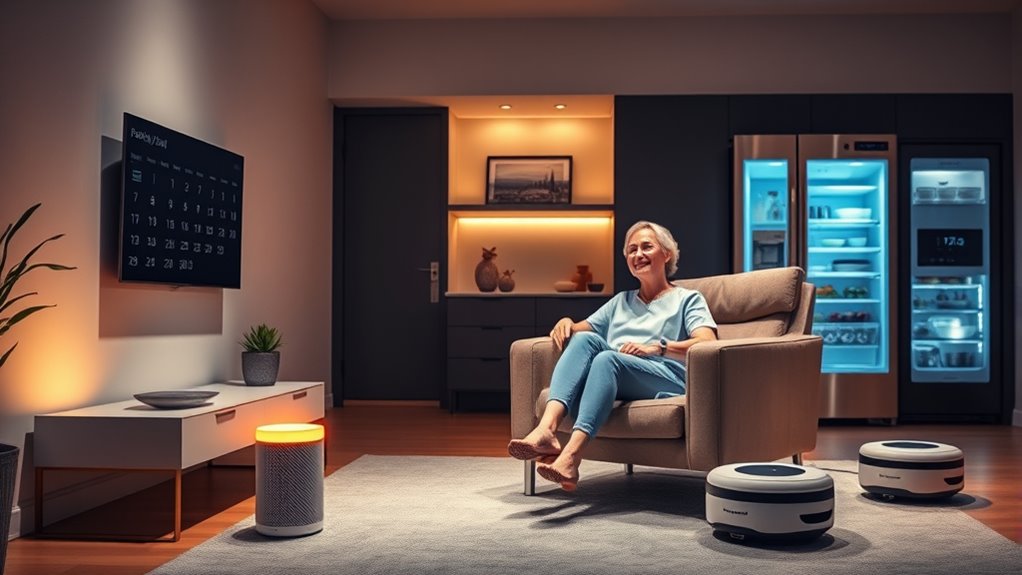
Smart home devices can considerably ease daily management for caregivers and seniors by automating routine tasks. With automation, you can effortlessly handle routine management, reducing your daily caregiving load.
For example:
- Use smart plugs, switches, and thermostats to remotely control lighting, temperature, and appliances, ensuring comfort and safety without constant oversight.
- Set voice-activated routines with Amazon Alexa or Google Assistant to schedule tasks like turning on lights or watering plants automatically.
- Implement automated medication dispensers like Hero Health to support medication adherence, helping seniors maintain independence.
These devices enhance caregiver support by maintaining routines seamlessly, alerting you to environmental issues, and freeing up your time for more personalized care.
Protecting the Home With Smart Emergency Devices

Smart emergency devices can automatically notify you or emergency services when something’s wrong, giving you peace of mind.
Integrating these systems with your home security setup guarantees thorough protection and quick response.
With features like alerts, cameras, and two-way communication, you can monitor and manage emergencies from anywhere.
Emergency Alert Systems
Have you ever wondered how technology can keep loved ones safe during emergencies? Smart emergency alert systems are a game-changer for safety, especially for older adults. They automatically notify caregivers or emergency services during incidents like falls or cardiac events, ensuring quick help.
Here are key features:
- Emergency alerts from devices like the Apple Watch Series 9 with fall detection send instant notifications during accidents.
- Sensors in systems like Ring Alarm detect hazards such as water leaks or suspicious activity and alert you via smartphone.
- Voice-controlled devices like Amazon Echo Show 8 enable quick communication with loved ones or emergency responders through voice commands or video calls.
These systems support independent living by providing rapid response, giving you peace of mind about your loved ones’ safety.
Home Security Integration
Integrating emergency devices into your home security system enhances safety and provides peace of mind. Smart home devices like the Ring Alarm system combine door/window sensors, cameras, and water leak detectors to create a thorough security network that you can monitor remotely.
This setup supports caregiver support by enabling real-time alerts and instant access to safety updates. Security cameras with two-way audio let you check on loved ones and communicate during emergencies, reducing anxiety.
Smart panic buttons and sensors can automatically alert emergency services or contacts, ensuring quick responses when needed. Compatibility with platforms like Alexa, Google Home, or Apple Home allows seamless integration, making your security routine more efficient and reliable for caring for your loved ones.
Choosing and Integrating the Right Devices
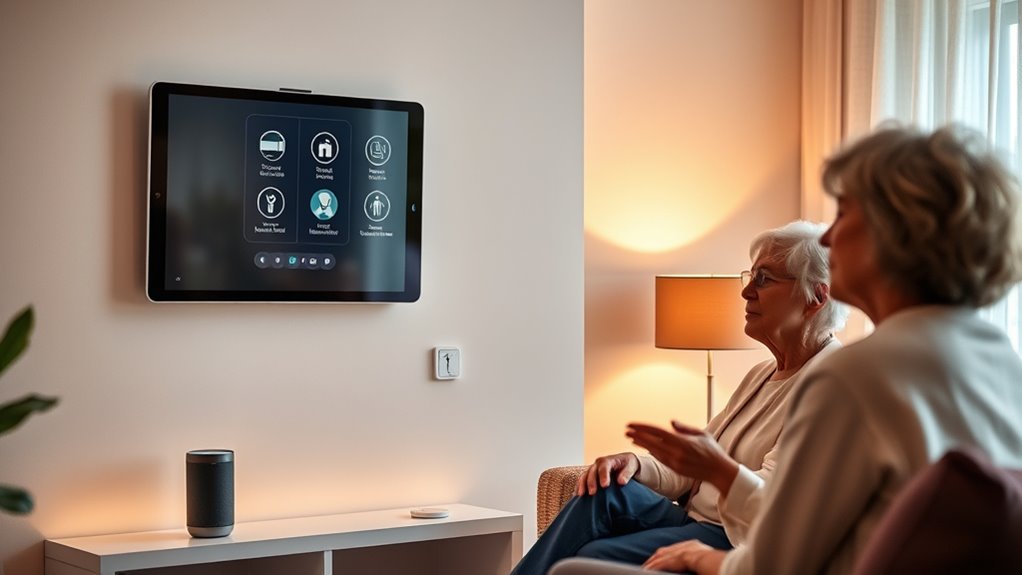
Choosing the right devices involves considering compatibility, ease of use, and safety features to guarantee they work seamlessly within your existing setup. When selecting smart devices for aging in place, focus on those that integrate smoothly across platforms like Alexa, Google Home, or Apple Home. This ensures you can control everything effortlessly.
Consider these key points:
- Pick user-friendly devices with simple setup and manual controls to make daily use easier for your loved ones.
- Prioritize safety-focused devices such as sensors, cameras, and alarms that send automatic alerts to caregivers.
- Start small with familiar devices like smart plugs or medication dispensers to build confidence and ensure smooth integration.
Enlisting family or professional support during setup can also make the process stress-free.
Overcoming Challenges and Ensuring Privacy
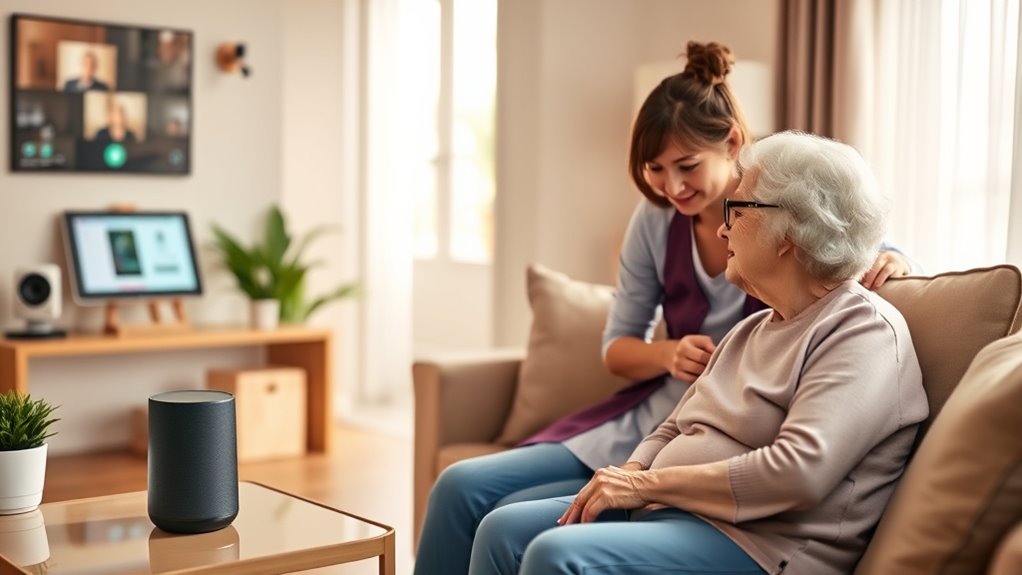
How can caregivers and older adults address privacy concerns while embracing smart home technology? The key is prioritizing security and building trust.
Choose devices that follow strict security standards and have transparent data policies, so you know how your information is used.
Balancing functionality with discreet design helps safeguard privacy without sacrificing convenience.
Educate yourself and your loved ones on managing privacy settings and data controls to stay in control of personal information.
Address interoperability issues and ensure devices are reliable to prevent unauthorized access to sensitive health and safety data.
By actively managing these factors, you can confidently adopt smart devices, knowing your privacy is protected.
This approach fosters trust and encourages acceptance of smart home technology for caregiving.
Future Trends in Smart Aging Support
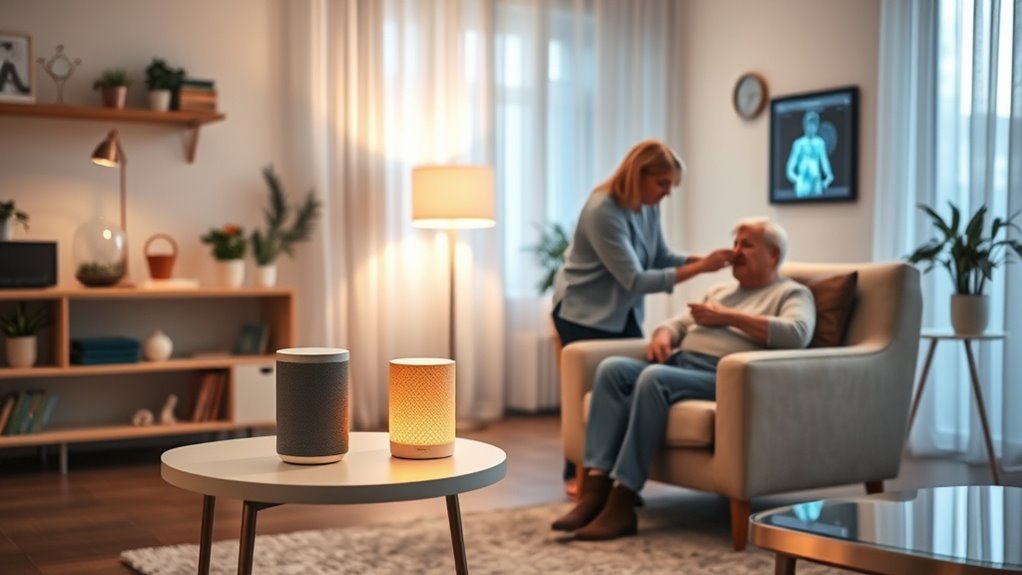
As technology continues to advance, smart aging support is poised to become more personalized and seamless, transforming how you and older adults manage daily living.
Future innovations will heavily rely on AI-driven solutions for tailored care, fall detection, and health monitoring, making interventions more proactive.
Interoperability will play a vital role, with devices supporting multiple platforms like Alexa, Google, and Apple, ensuring smooth integration and better caregiver oversight.
Additionally, advances in smart sensors and wearables will enable real-time health data collection, allowing timely responses to changes in health status.
Emerging trends focus on creating multi-functional, privacy-conscious devices that support aging in place while addressing usability and security concerns.
These developments will make caregiving more efficient and enhance quality of life for older adults.
Frequently Asked Questions
How Smart Homes Can Help the Elderly?
Smart homes help the elderly stay safe, comfortable, and independent. You can use cameras and sensors to monitor their activity remotely, receiving alerts for falls or emergencies.
Voice assistants make communication easy, reducing loneliness. Automated medication dispensers and environmental controls simplify daily routines, so they don’t need constant help.
How Are Caregivers Using Smart Tech to Help Aging Parents?
Imagine checking in with your aging parents from your phone, feeling reassured as smart cameras and sensors catch falls or unusual activity.
You use voice assistants to chat or remind them about medications, and smart locks ensure their home stays secure.
Automated routines adjust lights and temperature, making their space comfortable.
You’re constantly connected, managing their safety and health effortlessly, even from miles away, thanks to smart technology.
What Smart Home Devices Support Older Adults?
You can equip older adults with various smart home devices to support their safety and independence. Security cameras, motion sensors, and door alarms enable remote monitoring.
Voice assistants like Alexa or Google Home help with medication reminders and emergency calls. Smart lighting and thermostats ensure comfort.
Automated pill dispensers and wearable fall detectors promote health and safety. These devices make daily life easier and provide peace of mind for both you and your loved ones.
How Do Smart Devices Help Us in Home Management?
Oh, the marvels of modern convenience—who knew managing a home could be so effortless? Smart devices let you control lighting, thermostats, and appliances with a tap or voice command.
They automate routines, monitor safety, and even remind you to take your meds. With centralized platforms, you streamline chores and safeguard your loved ones.
It’s like having a personal assistant, minus the coffee breaks and attitude.
Conclusion
By harnessing smart home devices, you can make caregiving more effective and less stressful. Imagine a caregiver who uses motion sensors to monitor a loved one’s movements, ensuring safety without constant oversight. With the right technology, you’re empowered to provide better support, enhance independence, and respond swiftly to emergencies. Embracing these tools means you’re not alone—you’re equipped to create a safer, more connected environment for those you care for.

